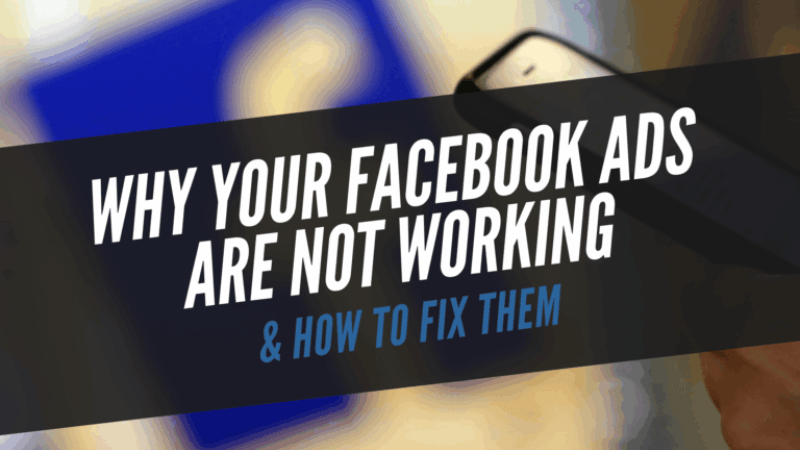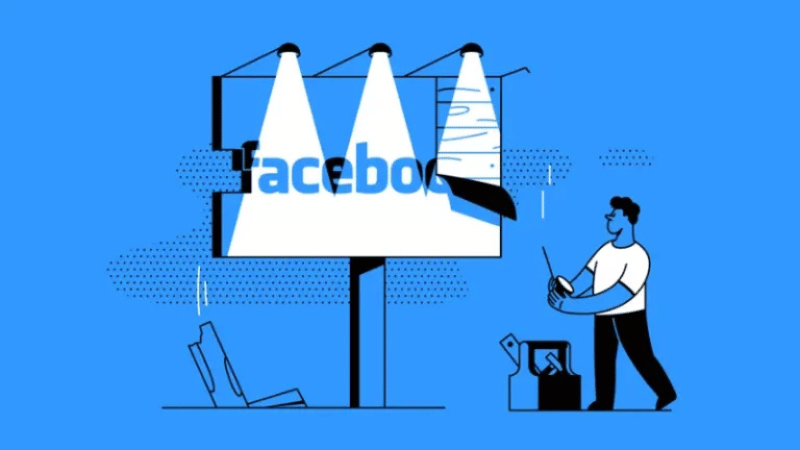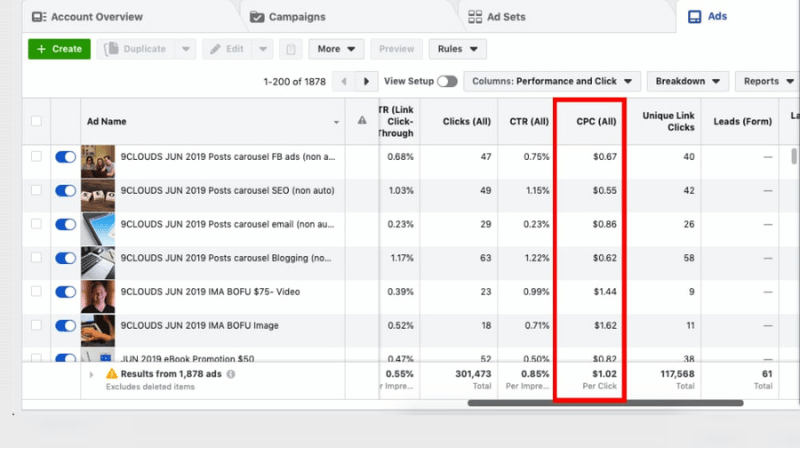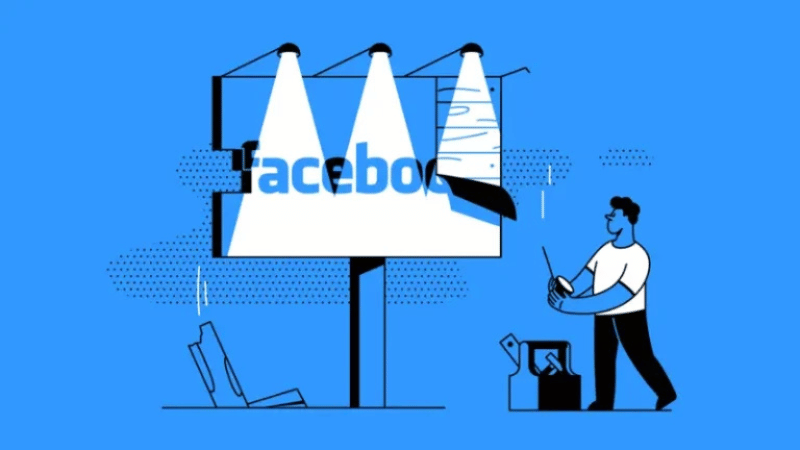We started running Facebook ads in 2012, and throughout that journey, we have accumulated countless valuable experiences in implementing campaigns on both Facebook and Instagram. However, not everything always goes smoothly. There are times when Meta Ads accounts have unexplainable problems, causing a clear drop in campaign effectiveness. In this article, Optimal Agency will analyze with you why running Facebook ads is ineffective, while also sharing solutions to help improve and break through campaign performance.
Why is running Facebook ads ineffective?
We have audited hundreds of Meta Ads accounts and found a commonality: 90% of small advertisers repeat the same mistakes. They often run an extremely broad campaign, retarget website visitors for 30–90 days, and rely on a few “win” ad creatives with only 20–30 purchases. The result? The cost keeps escalating, and the effectiveness is erratic, sometimes up, sometimes down. If you’ve also experienced this feeling, check out the main reasons below.
Common mistakes of small accounts

- Running an extremely broad target (hundreds of millions of people) → wasting the budget.
- Monotonous retargeting (30, 60, 90 days) → quickly reaching saturation.
- Relying on a few available ad creatives → a lack of testing and innovation.
An online fashion store we supported spent 50 million VND/month just to retarget an old customer group, but the conversion rate dropped below 0.8% because they didn’t refresh the content and had a weak digital infrastructure.
Lack of a comprehensive digital infrastructure
Customers don’t just look at ads. They will Google the brand, go to the website, check the Fanpage, Instagram, read reviews, and case studies. If the website loads slowly, the reviews are negative, and the Fanpage is inactive → customers will leave immediately.
Learn from competitors who are 2–3 years ahead.
Weak sales process
Leads from Facebook are often “colder” than Google Ads. If you respond slowly, the conversion rate is almost zero.
We once tested: calling customers in the first hour → the conversion rate was 70% higher than calling after 24 hours.
With e-commerce, a cosmetics shop reduced its checkout process from 5 steps to 2, and the completed purchase rate increased from 2.5% to 6.1%.
No attractive offers
An ad that just says “we sell product X” is unlikely to be effective. Customers need an immediate reason to be interested: a limited-time discount, a combo, or a gift.
For example, a home appliance brand that launched a 48-hour flash sale with a 20% discount increased its sales from Facebook Ads by 4 times compared to the previous week.
Not handling objections before the customer asks
Customers are always concerned about price, quality, and warranty. If you don’t answer early, they will leave.
A real estate company we consulted with added the message “the final price is unchanged, committed to being up to 15% lower than the market.” The result: the cost per lead decreased by 35%, and the conversion rate increased sharply.
Lack of multi-channel touchpoints
According to the 7–11–4 rule, a customer needs 7 hours of interaction, across 11 touchpoints, on 4 different platforms before buying. If you only run Facebook Ads, it will be very difficult to convince them.
A fitness brand combined: Facebook Ads + YouTube reviews + email funnel. After 3 months, the percentage of customers who bought a training package doubled.
Choosing the wrong campaign type or optimization objective
Running traffic ads and hoping customers buy on their own is a big mistake. If you want sales → choose a Sales Campaign. If you want leads → run Lead Ads.
A furniture store experimented: with the same budget of 30 million VND, traffic ads only brought in 200 low-quality leads, while lead ads brought in 500 potential leads, with a much higher conversion rate. To better understand each type of Facebook ads, you can refer to our blog post.
Poor website quality
Your website is your online “store.” If it’s not professional, customers will leave in a few seconds. The necessary checklist includes:
- A modern interface that loads quickly (under 3 seconds).
- Clear images, videos, and testimonials.
- A prominent CTA and a personalized experience.
A phone accessory shop, after optimizing its page load speed from 6s to 2.5s, increased its conversion rate from 1.2% to 3.8%.
How to fix ineffective ad campaigns for brands
When running ads on Meta, many people or small advertisers often fall into the situation of “the more you run, the more you lose,” while big brands are aggressively expanding their campaigns with sustainable profits. So what did they do? We will share the core principles to help you apply and optimize for effectiveness.
3 Important principles applied by big brands
Big brands often rely on 3 important principles:
- Account structure prioritizes machine learning: They provide as much data as possible to the algorithm. For example, a cosmetics brand in the US grouped its campaigns instead of splitting them, which helped the system learn faster and reduced CPA by 28% in just 2 weeks.
- Volume of creative and version tracking: This is where many of you fail. If you only have 1–2 ad creatives, the system has a hard time optimizing. In contrast, big brands often have dozens of variations of images, videos, and ad copy to test continuously.
- Track real financial metrics: Instead of just looking at CTR, CPM, or CPC, they focus on CAC, Contribution Margin, LTV—metrics that directly affect profit.
This is why big brands can expand their budgets by hundreds of thousands of USD while maintaining stable profits.
Set up a campaign structure according to the budget

- Accounts <10k USD/month: Often make 2 common mistakes—either too simple (only 2–3 campaigns) or too messy (many small 20 USD campaigns). The result is that the system doesn’t have enough data to optimize.
- Accounts >10k USD/month: Need to have detailed campaign testing according to the principle of 1 audience – 1 angle – 1 theme.
For example, the brand Obby (personal care) used the theme “Confidence through self-care,” then developed it into many small angles like “Empowered self-care,” “Nourishing confidence,” and “Confidence starts with self-love.” Each angle then had dozens of variations in ad copy, images, and videos to test in parallel.
Key Points
- Clearly classify audiences: new customers, old customers, and engaged audiences.
- Track creative at the theme – angle – asset level: to know exactly what is converting well.
- Measure finances with real numbers: CAC, ROAS, Gross Profit, Contribution Margin, LTV—these are the survival metrics, not CTR or CPC.
- Accelerate the launch of ads: Big brands often launch 100–300 ads per month to have enough data and continuously improve.
Hire an Agency to break through faster
If you don’t have enough internal resources to implement, collaborating with a long-experienced Agency is a smart solution. An Agency can help you set up the campaign correctly, optimize the budget, and quickly update changes from Meta’s algorithm to maintain sustainable effectiveness. If you need to rent an account to run with the support of experts, contact Optimal Agency.
When you partner with Optimal Agency, you will be granted the right to use high-quality Agency accounts with a solid trust level, a stable activity history, and a strong “spending” ability. All accounts are nurtured by us in a dedicated Proxy/VPS environment, ensuring a clean, reputable, and absolutely safe IP.
We don’t just provide accounts; our team of experienced Facebook Ads experts will accompany you throughout the implementation process: from guiding you on how to set up the campaign, building standardized content, and optimizing ad performance, to setting up the Pixel, verifying the Fanpage & Domain, and even designing a professional landing page to increase the conversion rate.
Tips to fix a sudden drop in ROAS for Facebook ad campaigns
During the process of running ads, many of you or advertisers have probably encountered a situation where a stable campaign suddenly “falls off a cliff.” This makes us confused, not knowing what the cause is or how to handle it. Here are the practical experiences we have applied and want to share with you.

Check the cause before rushing to conclusions
Many people often think that a drop in ad effectiveness is due to ad fatigue—meaning users have seen the ad too many times and have lost interest. However, when we checked the frequency, the number was not high. That proves the cause doesn’t always come from customer boredom.
There have been cases where an advertiser changed the target continuously, created new ad sets… but in the end, the effectiveness still didn’t improve. This is a situation that many people in the advertising community jokingly call “scratching their heads in confusion.”
Try a “Reset” by Duplicating the Campaign

A solution that is quite simple but often brings unexpected results is to duplicate the campaign or ad set and run it again from the beginning. Important: you must turn off the old version; you should not run them in parallel because it can easily cause overlapping audiences.
We can see this as “restarting the app” when the phone freezes. Meta also has a learning phase, and duplicating helps the system reset the distribution data.
A real example: we once had a campaign where the ROAS dropped from 5x to 2x, and after duplicating and restarting it, the ROAS bounced back to 5x almost immediately after a few days. Although it’s not a 100% guarantee, it’s a quick, low-risk experiment that is well worth applying.
External factors
In addition to technical issues from Meta’s system, many other factors affect ROAS:
- Real ad fatigue: at this point, you need to change the creative—it could be a new image, video, headline, or message.
- Seasonality: for example, the tourism industry is often slow during the rainy season.
- Competitors: they may have just launched a more attractive offer, causing customers to shift.
The important thing is that we must verify each hypothesis. Try resetting the campaign by duplicating it; if the results improve, that’s great, but if not, at least you have ruled out one cause and have a basis to continue analyzing other factors.
The ineffectiveness of Facebook ads can come from many different reasons, from the targeting method and creative content to technical or market competition factors. It’s important that you analyze the problem correctly, test flexibly, and optimize continuously. If you know how to combine strategy, content, and tools, your campaign can completely break through and bring results beyond expectations.
Frequently Asked Questions
If you find that running your own ads is not effective, you can hire a Facebook ad service from a reliable unit. However, it’s best to still cultivate knowledge about Facebook Ads and run the ads yourself to control costs better. But if you need the support of Facebook Ads experts, you should rent an ad account from Optimal Agency. Here, you not only get a quality, high-trust ad account but also receive enthusiastic support from experts to implement effective campaigns.
The answer is no; they are not expensive if you know how to optimize the ad bid, and the cost will be much lower. In addition, compared to other advertising channels, Facebook is an effective advertising channel with a relatively cheap running cost and bid price.